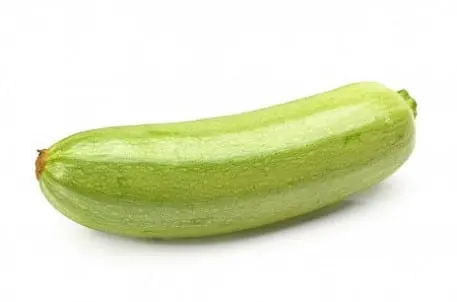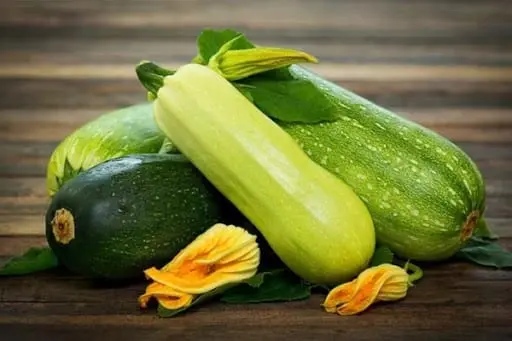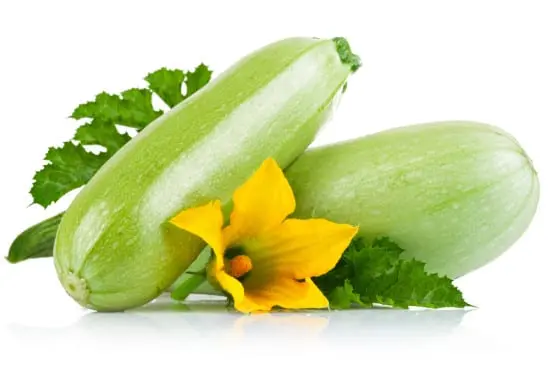Contents
An affordable vegetable like squash or zucchini is very healthy and essential for the heart, brain, muscles and liver.
History of zucchini
According to an Indian legend, a zucchini is a gift to people from the inhabitants of heaven. For thousands of years, the population of South America have used this “divine gift” in their cooking, and the conquistadors brought zucchini to the Old World. The fate of zucchini in Europe was paradoxical: it spread and fell in love everyone to themselves very quickly, but … not at all as food!
The storehouse of vitamins, minerals and trace elements for two centuries was just an ornamental exotic plant. It was revered for its large and bright flowers, not realizing that the fruits are of much greater value.
Useful properties of zucchini
Zucchini pulp is easily absorbed by the body and does not irritate the stomach and intestines. In addition, the unpretentious vegetable contains vitamin C, which is involved in the production of collagen, which gives the skin its elasticity.
Beta-carotene, which is found in zucchini, is good for the skin, hair and has a good effect on eyesight. Also in zucchini you will find all trace elements important for the body: potassium, calcium, iron, magnesium, necessary for the heart, brain, muscles and liver.
And their dietary fiber adsorbs toxic substances, excess cholesterol and water remov them from the body. Also, zucchini dishes activate the digestive processes, improve the motor and secretory functions of the stomach and intestines.
This vegetable prevents fluid retention in the body, and its calorie content is close to zero. 100 g of zucchini contains only 16.7 kilocalories.

Harmful properties of zucchini
There is very little harm to the body from such a vegetable as zucchini. The main harmful property is that zucchini contains a large property of potassium, therefore, because of this, it should not be consumed by people suffering from kidney diseases.
In very rare cases zucchini are contraindicated for peptic ulcer and gastritis.
Allergy to squash
Despite the fact that zucchini belongs to the category of hypoallergenic foods, it can provoke a negative reaction. Most often we are talking about a genetic predisposition. Moreover, for adults, the reaction is often protracted, which does not occur immediately after eating, but in case of children it manifests itself almost immediately.

Allergy symptoms for babies:
- Diathesis;
- Dermatitis;
- Frequent regurgitation, even vomiting;
- Dry cough attacks, runny nose.
General clinical picture:
- Inflammation of the mucous membranes;
- Redness and rash on the skin;
- Nausea, vomiting;
- Diarrhea;
- Severe pain in the abdomen;
- Less commonly – tearing and nasal congestion.
In especially difficult situations (very rarely), anaphylactic reactions are possible, which carry a direct threat to human life. In this case, an ambulance is called immediately. Before the arrival of doctors, they do not take any measures, especially if a small child has signs of an allergic reaction.

Important: anaphylaxis is characterized by edema of the mucous membranes and tissues of the oral cavity, nasopharynx, as well as a sharp decrease in blood pressure (hypotension). In no case should you hesitate in contacting specialists.
After providing first aid, if necessary, the patient is recommended to be examined and tested. Only according to the results of laboratory tests, the doctor prescribes therapy, if any.
Zucchini allergy treatment
Basically, this disease does not require medication, except sorbents, in order to quickly remove the dangerous substance from the body. The main therapy is diet and complete rejection of the allergen – this applies to both children and adults.
The use of zucchini in cooking
You can cook a lot of tasty and healthy dishes from zucchini that can satisfy even the most fastidious gourmet. In raw or lightly boiled form, zucchini is used in vegetable salads; young fruits with delicate pulp and thin skin are suitable for this.
Zucchini are suitable for consumption in different stages of ripening. Young fruits can be used both raw and boiled, fried, baked, pickled; mature vegetables have a denser skin and pulp, so it is recommended to heat them. Flowers and seeds of some varieties of squash are also eaten.
With zucchini and some other ingredients, it’s easy to prepare a full multi-course meal, including dessert. Young vegetables will make a delicious and delicate soup-puree, for the second, vegetable stew, stuffed or fried zucchini are quite suitable, and pancakes or zucchini cakes as a dessert.
In Italy sauces for pasta are prepared from zucchini, in India they are served with fish or seafood, in Russia the famous zucchini caviar is incredibly popular – a piquant appetizer made from boiled or fried zucchini with the addition of carrots, onions, bell peppers, tomatoes and aromatic spices.
Zucchini caviar is far from uncommon on store shelves, but this homemade snack is especially tasty. Homemade zucchini caviar recipes may differ from traditional ones in the composition of vegetables and seasonings, or in the way they are chopped and cooked.
Pickled zucchini are very tasty, they taste like mushrooms or cucumbers – it depends on the method of preparation and the composition of the spices. They are served on the table as a cold appetizer or a side dish, added to salads.
There are a huge number of recipes for baking zucchini – pancakes, casseroles, pancakes, muffins, pies. But perhaps the most original dish is marrow jam, which has an unusual taste and aroma. Zucchini jam is prepared with the addition of citrus fruits – lemons or oranges, as well as apples, which give the dessert a unique taste.
There are many ways to cook zucchini – you can use both ready-made recipes and experiment, inventing new dishes from this tasty and healthy vegetable!

15 interesting facts about Zucchini
- From a botanical point of view, they belong to berries, not vegetables. But still, everyone is used to considering zucchini a vegetable.
- Some varieties of zucchini, in favorable conditions, 45-50 days after sowing the seeds already grow to such a size that they can be harvested.
- For the first time, Italians began to eat zucchini themselves. Before that, only their flowers or seeds were eaten.
- These vegetables are hypoallergenic.
- Despite the fact that they do not differ in sour taste, they contain a lot of vitamin C.
- Zucchini is a dietary product. Depending on the variety and degree of maturity, 100 grams of their pulp contains an average of 24-26 kcal.
- If you accidentally damage the top layer of the skin of this vegetable, it will quickly deteriorate. Even refrigeration won’t help.
- Zucchini were introduced to Europe in the 16th century. At the same time, they served as ornamental plants, and no one even thought to eat them.
- Eating zucchini in moderation can help keep hair from turning gray.
- These vegetables, because of their low calorie content, are included in hundreds of different diets.
- The largest squash ever grown weighed 61 kg. This world record was set in 1998.
- The pulp of fresh zucchini perfectly nourishes and moisturizes the skin, which is why face masks are often made from it.
- In Greece and France, the aforementioned zucchini flowers are popular, which are also edible.
- For the first time, zucchini appeared on the territory of modern Mexico. But the local habitants ate only their seeds, not the vegetables themselves.
- Some varieties of zucchini are eaten raw – they are added to a variety of salads.









